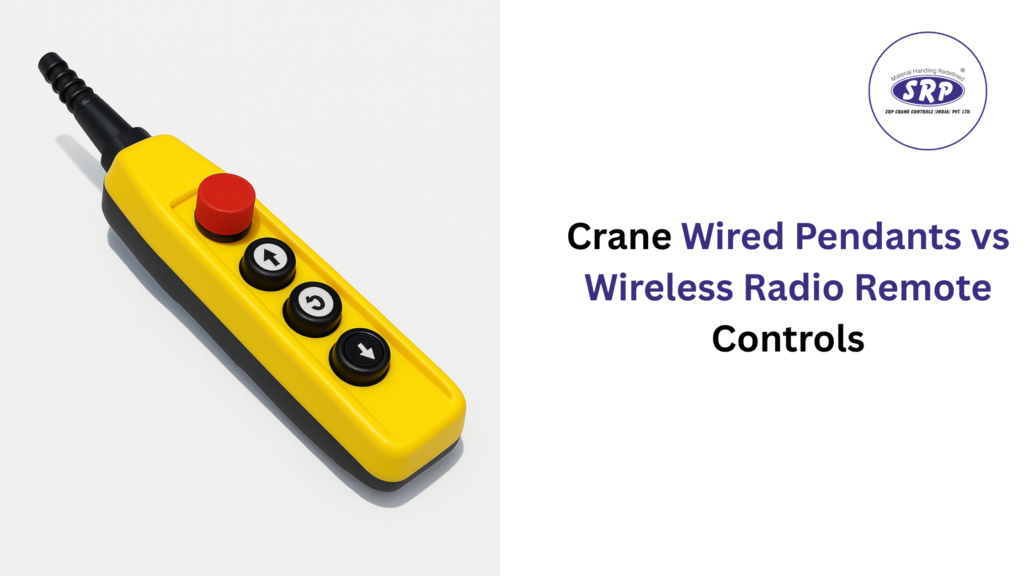
In the dynamic world of industrial operations, particularly in crane management, the choice of control systems can significantly impact both efficiency and safety. Industrial control systems encompass a variety of technologies that enable operators to manage equipment effectively. Among these, wired pendants and wireless radio remote controls stand out as two prominent methods for controlling cranes.
This article delves into the intricacies of these control systems, providing insights for business owners to understand their options better.
Understanding Wired Pendants in Industrial Control Systems
What are Wired Pendants?
Wired pendant controls are traditional devices used to operate cranes, featuring a physical connection via cables. These controls are straightforward and reliable, particularly suited for environments where operators work close to the machinery. Wired pendant control excels in straightforward lifting tasks where operators are positioned close to the crane. This direct connection ensures that the operator has immediate feedback from the crane’s movements.
Advantages of Wired Pendants
The primary advantage of wired pendants lies in their dependability. Because they are hardwired into the hoist or festoon system, there is no risk of interference from other signals, making them incredibly reliable in busy industrial settings. Furthermore, wired controls are less susceptible to mechanical damage and environmental pollutants due to their robust construction. They are often favored for cranes operating in hazardous environments where explosion-proof equipment is necessary.
Another significant benefit is that wired pendants do not require batteries or frequent maintenance related to power supply issues. The crane controls will always have power because they are hardwired into the electrification system, ensuring uninterrupted operation. This aspect makes them an attractive option for organizations facing budget constraints, as the initial purchase price tends to be lower than that of advanced wireless systems.
Disadvantages of Wired Pendants
However, wired pendants come with their own set of challenges. The most notable drawback is the limitation on operator mobility. Cables can create tripping hazards, particularly in confined spaces, which can lead to accidents and downtime. Additionally, if a cable is damaged, repairs can be costly and time-consuming, halting operations until the issue is resolved.
Exploring Wireless Radio Remote Controls in Industrial Control Systems
What are Wireless Radio Remote Controls?
Wireless radio remote controls represent a modern evolution in crane operation technology. These devices allow operators to control cranes without being tethered by cables, enhancing flexibility and freedom of movement. Wireless radio communication provides more reliability even in harsh environments. This adaptability makes wireless systems increasingly popular across various industrial applications.
Advantages of Wireless Radio Remote Controls
The advantages of wireless radio remote controls are compelling. First and foremost is increased safety. Operators can maintain a safe distance from heavy machinery while still retaining full control over operations. This separation significantly reduces the risk of accidents caused by unexpected machine movements or malfunctions. A study by the National Safety Council highlights that implementing remote control systems has led to a 35% reduction in operator-related accidents.
Moreover, wireless controls enhance productivity by allowing one operator to manage multiple machines simultaneously without being physically present at each one. This capability not only streamlines operations but also reduces labor costs as fewer personnel are needed on-site.
Another critical benefit is ergonomics. Wireless remote controls are designed with user comfort in mind, minimizing physical strain on operators during prolonged use. The lightweight design allows for easy handling and reduces the risk of repetitive strain injuries (RSIs), which account for a significant percentage of workplace injuries.
Disadvantages of Wireless Radio Remote Controls
Despite their advantages, wireless systems are not without drawbacks. One concern is potential signal interference in environments filled with heavy machinery. While advances in technology have mitigated many issues related to signal loss or degradation, it remains a consideration for some operations.
Furthermore, reliance on batteries means that regular maintenance checks are necessary to ensure functionality. Operators must be vigilant about battery life and performance to avoid interruptions during critical operations.
Comparative Analysis of Control Methods in Industrial Control Systems
When comparing wired pendants and wireless radio remote controls, several performance metrics come into play:
Wired pendants excel in stability and reliability due to their direct connection; however, they limit operator mobility and can create hazards within the workspace. In contrast, wireless systems provide greater flexibility and safety but require careful management of battery life and potential signal interference.
Industry Trends and Future Directions in Industrial Control Systems
The landscape of industrial control systems is rapidly evolving with technological advancements paving the way for smarter solutions. The integration of IoT (Internet of Things) technologies into crane operations is becoming increasingly prevalent. These innovations allow for real-time monitoring and management of crane functions from centralized locations, enhancing operational efficiency.
Moreover, as industries shift towards automation and smart manufacturing practices, wireless radio remote controls are gaining traction as a preferred choice due to their adaptability and ease of integration with existing systems. The evolution reflects a commitment to optimizing operations while prioritizing operator safety.
Conclusion
In conclusion, both wired pendants and wireless radio remote controls offer unique advantages and challenges within industrial control systems for cranes. While wired options provide reliability and lower initial costs, they restrict operator movement and can pose safety risks due to tripping hazards.
On the other hand, wireless radio remote controls enhance safety through improved ergonomics and mobility while allowing operators to manage multiple machines from safer distances. As industries continue to embrace technological advancements, wireless solutions appear poised to dominate the market due to their flexibility and efficiency.For those looking to explore options tailored specifically to their operational needs, consulting experts at SRP Remote can provide valuable insights into selecting the most effective control system for your crane operations. Embracing modern technology not only enhances productivity but also prioritizes safety—a crucial consideration in today’s industrial landscape.

